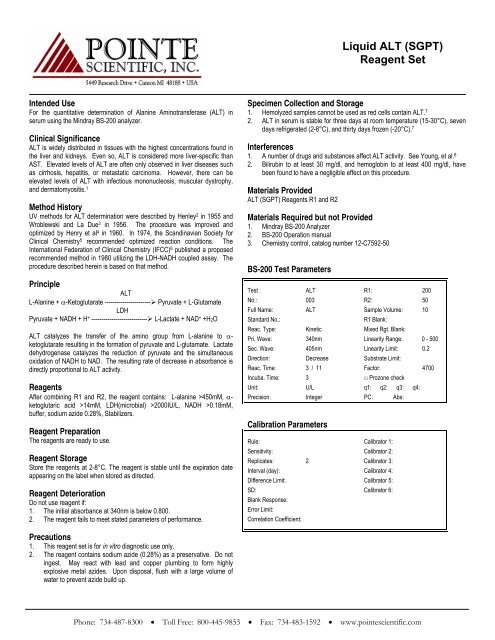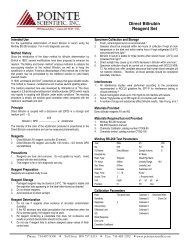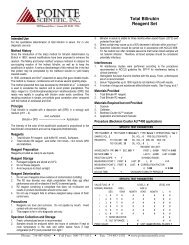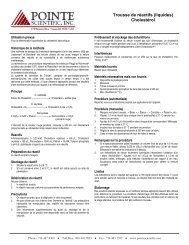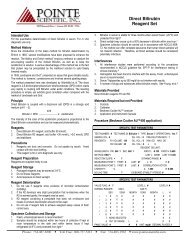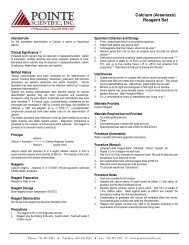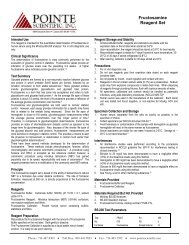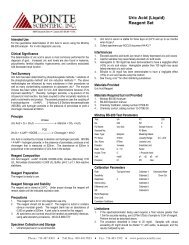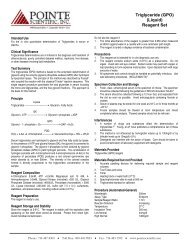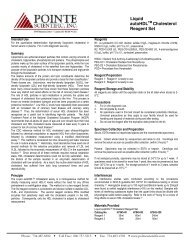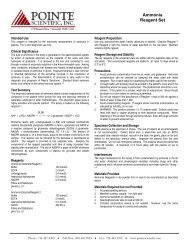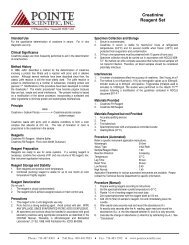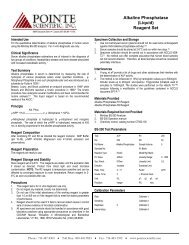12-A7526-100 - Pointe Scientific, Inc.
12-A7526-100 - Pointe Scientific, Inc.
12-A7526-100 - Pointe Scientific, Inc.
Create successful ePaper yourself
Turn your PDF publications into a flip-book with our unique Google optimized e-Paper software.
Liquid ALT (SGPT)<br />
Reagent Set<br />
Intended Use<br />
For the quantitative determination of Alanine Aminotransferase (ALT) in<br />
serum using the Mindray BS-200 analyzer.<br />
Clinical Significance<br />
ALT is widely distributed in tissues with the highest concentrations found in<br />
the liver and kidneys. Even so, ALT is considered more liver-specific than<br />
AST. Elevated levels of ALT are often only observed in liver diseases such<br />
as cirrhosis, hepatitis, or metastatic carcinoma. However, there can be<br />
elevated levels of ALT with infectious mononucleosis, muscular dystrophy,<br />
and dermatomyositis. 1<br />
Method History<br />
UV methods for ALT determination were described by Henley 2 in 1955 and<br />
Wroblewski and La Due 3 in 1956. The procedure was improved and<br />
optimized by Henry et al 4 in 1960. In 1974, the Scandinavian Society for<br />
Clinical Chemistry 5 recommended optimized reaction conditions. The<br />
International Federation of Clinical Chemistry (IFCC) 6 published a proposed<br />
recommended method in 1980 utilizing the LDH-NADH coupled assay. The<br />
procedure described herein is based on that method.<br />
Principle<br />
ALT<br />
L-Alanine + α-Ketoglutarate -----------------------‣ Pyruvate + L-Glutamate<br />
LDH<br />
Pyruvate + NADH + H + ----------------------------‣ L-Lactate + NAD + +H2O<br />
ALT catalyzes the transfer of the amino group from L-alanine to α-<br />
ketoglutarate resulting in the formation of pyruvate and L-glutamate. Lactate<br />
dehydrogenase catalyzes the reduction of pyruvate and the simultaneous<br />
oxidation of NADH to NAD. The resulting rate of decrease in absorbance is<br />
directly proportional to ALT activity.<br />
Reagents<br />
After combining R1 and R2, the reagent contains: L-alanine >450mM, α-<br />
ketoglutaric acid >14mM, LDH(microbial) >2000IU/L, NADH >0.18mM,<br />
buffer, sodium azide 0.28%, Stabilizers.<br />
Reagent Preparation<br />
The reagents are ready to use.<br />
Reagent Storage<br />
Store the reagents at 2-8°C. The reagent is stable until the expiration date<br />
appearing on the label when stored as directed.<br />
Reagent Deterioration<br />
Do not use reagent if:<br />
1. The initial absorbance at 340nm is below 0.800.<br />
2. The reagent fails to meet stated parameters of performance.<br />
Specimen Collection and Storage<br />
1. Hemolyzed samples cannot be used as red cells contain ALT. 7<br />
2. ALT in serum is stable for three days at room temperature (15-30°C), seven<br />
days refrigerated (2-8°C), and thirty days frozen (-20°C). 7<br />
Interferences<br />
1. A number of drugs and substances affect ALT activity. See Young, et al. 8<br />
2. Bilirubin to at least 30 mg/dl, and hemoglobin to at least 400 mg/dl, have<br />
been found to have a negligible effect on this procedure.<br />
Materials Provided<br />
ALT (SGPT) Reagents R1 and R2<br />
Materials Required but not Provided<br />
1. Mindray BS-200 Analyzer<br />
2. BS-200 Operation manual<br />
3. Chemistry control, catalog number <strong>12</strong>-C7592-50<br />
BS-200 Test Parameters<br />
Test : ALT R1: 200<br />
No.: 003 R2: 50<br />
Full Name: ALT Sample Volume: 10<br />
Standard No.:<br />
R1 Blank:<br />
Reac. Type: Kinetic Mixed Rgt. Blank:<br />
Pri. Wave: 340nm Linearity Range: 0 - 500<br />
Sec. Wave: 405nm Linearity Limit: 0.2<br />
Direction: Decrease Substrate Limit:<br />
Reac. Time: 3 / 11 Factor: 4700<br />
<strong>Inc</strong>uba. Time: 3 □ Prozone check<br />
Unit: U/L q1: q2: q3: q4:<br />
Precision: Integer PC: Abs:<br />
Calibration Parameters<br />
Rule: Calibrator 1:<br />
Sensitivity: Calibrator 2:<br />
Replicates: 2 Calibrator 3:<br />
Interval (day): Calibrator 4:<br />
Difference Limit: Calibrator 5:<br />
SD: Calibrator 6:<br />
Blank Response:<br />
Error Limit:<br />
Correlation Coefficient:<br />
Precautions<br />
1. This reagent set is for in vitro diagnostic use only.<br />
2. The reagent contains sodium azide (0.28%) as a preservative. Do not<br />
ingest. May react with lead and copper plumbing to form highly<br />
explosive metal azides. Upon disposal, flush with a large volume of<br />
water to prevent azide build up.<br />
Phone: 734-487-8300 • Toll Free: 800-445-9853 • Fax: 734-483-1592 • www.pointescientific.com
Liquid ALT (SGPT)<br />
Reagent Set<br />
Limitations<br />
1. Turbid or highly icteric samples may give readings whose initial<br />
absorbance exceeds the capabilities of the spectrophotometer. More<br />
accurate results may be obtained by using 0.05ml (50ul) of sample and<br />
multiplying the final answer by two.<br />
2. Samples with values above 500 IU/L should be diluted 1:1 with saline,<br />
re-assayed and the results multiplied by two.<br />
Calibration<br />
The procedure is standardized by means of the millimolar absorptivity of<br />
NADH taken as 6.22 at 340nm under the test conditions described.<br />
Calculation (Example)<br />
One international Unit (IU/L) is defined as the amount of enzyme that<br />
catalyzes the transformation of one micromole of substrate per minute under<br />
specified conditions.<br />
ALT (IU/L) = ΔAbs./Min. x 1.10 x <strong>100</strong>0 = ΔAbs./min. x 1768<br />
6.22 x 0.10 x 1.0<br />
Where ΔAbs./Min. = Average absorbance change per minute<br />
<strong>100</strong>0 = Conversion of IU/ml to IU/L<br />
1.10 = Total reaction volume (ml)<br />
6.22 = Millimolar absorptivity of NADH<br />
0.10 = Sample Volume (ml)<br />
1.0 = Light path in cm<br />
Example: If the average absorbance change per minute = 0.<strong>12</strong> then 0.<strong>12</strong> x<br />
1768 = 2<strong>12</strong> IU/L<br />
NOTE: If test parameters are altered the factor has to be recalculated using<br />
the above formula.<br />
3. Precision: Precision studies were performed using the Mindray BS-200<br />
analyzer following a modification of the guidelines which are contained in<br />
NCCLS document EP5-T2. 10<br />
Within Run (n=20)<br />
Day to Day (n=20)<br />
Mean S.D. C.V.% Mean S.D. C.V.%<br />
35.4 1.3 3.6 41.8 1.5 3.6<br />
89.5 1.1 1.3 111.9 2.6 2.3<br />
4. Sensitivity: The sensitivity for this reagent was investigated by reading the<br />
change in absorbance at 340nm for a saline sample and serums with known<br />
concentrations. Ten replicates were performed. The results of this<br />
investigation indicated that, on the analyzer used, the ALT (SGPT) reagent<br />
showed little or no reagent drift on a zero sample. Under the reaction<br />
conditions described, 1 U/L ALT activity gives a ΔAbs/Min. of 0.0004.<br />
References<br />
1. Tietz, N.W., Fundamentals of Clinical Chemistry, W.B. Saunders co., p 674 &<br />
675 (1982).<br />
2. Henley, K.S., Pollard, H.M., J. Lab. Clin. Med. 46:785 (1955).<br />
3. Wroblewski, F., La Due, J.S., Proc. Soc. Exp. Biol. Med. 91:569 (1956).<br />
4. Henry, R.J., et al, Am. J. Clin. Path. 34:381 (1960).<br />
5. The Committee on Enzymes of the Scandinavian Society for Clinical<br />
Chemistry and Clinical Physiology, Scand. J. Clin. Lab. Invest 32:291 (1974).<br />
6. Clinica Chimica Acta 105:145F-172F (1980).<br />
7. Henry, R.J., Clinical Chemistry: Principles and Technics, Harper & Row, NY,<br />
P522 (1968).<br />
8. Young, D.S., et al, Clin. Chem. 21:1D (1975).<br />
9. Henry, J.B., Clinical Diagnosis & Management by Laboratory Methods, W.B.<br />
Saunders Co., Philadelphia, P1437 (1984).<br />
10. NCCLS document “Evaluation of Precision Performance of Clinical<br />
Chemistry Devices”, 2 nd Ed. (1992).<br />
SI Units: To convert to SI Units (nkat/L) multiply IU/L by 16.67.<br />
Quality Control<br />
The validity of the reaction should be monitored using control sera with<br />
known normal and abnormal ALT (SGPT) values. These controls should be<br />
run at least with every shift in which ALT (SGPT) assays are performed. It is<br />
recommended that each laboratory establish its own frequency of control<br />
determination. Quality control requirements should be performed in<br />
conformance with local, state, and/or Federal regulations or accreditation<br />
requirements.<br />
Rev. <strong>12</strong>/09 P803-<strong>A7526</strong>-MIN<br />
Expected Values 9<br />
4 to 24 IU/L (30°C)<br />
4 to 36 IU/L (37°C)<br />
Since the expected values are affected by age, sex, diet, and geographical<br />
location, each laboratory is strongly urged to establish its own reference<br />
range for this procedure.<br />
Performance<br />
1. Linearity: 0-500 IU/L.<br />
2. Comparison: A study was performed between the Mindray BS-200 and<br />
a similar analyzer using this method, resulting in a correlation<br />
coefficient of 0.999 and a regression equation of y=0.94x + 5.8. (n=33).


